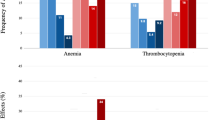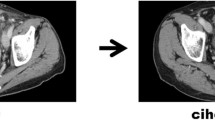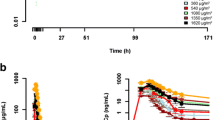Summary
The oxazaphosphorine analog ifosfamide (IFO) has demonstrated an increased therapeutic index in a variety of solid tumors and hematologic malignancies compared with its parent compound cyclophosphamide. A fractionated dose schedule over 5 days as continuous infusion in combination with the uroprotective agent sodium-2-mercapto-ethane-sulfonate (mesna) is considered to provide an improved therapeutic/toxic ratio. Stability data of IFO demonstrate long-term stability for use in disposable infusion pumps as outpatient treatment. In all, 52 patients with various malignancies were entered in a feasibility study to receive outpatient continuous infusion of IFO. All patients were required to have a subcutaneous venous port system implanted. The following drug combinations were used: IFO as single agent, IFO/mitoxantrone, IFO/carboplatinum/etoposide, IFO/etoposide/MTX, IFO/epirubicin. Mitoxantrone and epirubicin were given as continuous infusion together with IFO. Starting dose of IFO was between 1.6–2.0 g/m2/day×5 and was increased in absence of major hematologic or peripheral toxicitiy. Mesna was given in combination with IFO as continuous infusion at a dose of 50% of that calculated for IFO. No renal, bladder or central nervous system toxicity was observed. In 247 courses of outpatient continuous ifosfamide infusion only few technical complications due to improper handling were documented.
Similar content being viewed by others
Abbreviations
- IFO:
-
ifosfamide
References
Bramwell VHC, Mouridsen HT, Santoro A, et al. (1987) Cyclophoshamide versus ifosfamide: final report of a randomized phase II trial in adult soft tissue sarcoma. Eur J Cancer Clin Oncol 23:311–321
Posey LE, Morgan L, Carter RD, et al. (1980) A comparison of cyclophosphamide and ifosfamide in advanced bronchogenic carcinoma. Proc Am Assoc Cancer Res 19:338 (Abstr.)
Teufel G, Pfleiderer A (1976) Ifosfamid im Vergleich zu Endoxan bei fortgeschrittenen Ovarialkarzinomen. Geburtsh Frauenheilk 36:274
Tucker WG (1977) Ifosfamide in the treatment of lung cancer. In: Burkert H, Voigt HC (eds) Proceedings of the International Holoxan Symposium, Düsseldorf. Asta-Werke, Bielefeld, p 132
Nelson RL, Allen LM, Creaven PC (1975) Pharmacokinetics of divided dose ifosfamide. Clin Pharmacol Ther 19:365–370
Klein HO, Dias Wickramanayake P, Coerper C, et al. (1973) High-dose ifofamide and mesna as continuous infusion over five days. A phase I/II trial. Cancer Treat Rev 10:167–173 (Suppl A)
Rowland CG, Bradford E, Adams P, et al. (1984) Infusion of ifosamide and mesna. Lancet 2:468 (letter)
Radford JA, Margison J, Dunn G, et al. (1989) The stability of ifosfamide and ifosfamide/mesna in aqueous solution. Proceedings ECCO 5:89, Abstract 6.3.25
Elias A, Ryan L, Sulkes A, et al. (1989) Response to mesna, doxorubicin, ifosfamide and dacarbazine in 108 patients with metastatic or unresectable sarcoma and no prior chemotherapy. J Clin Oncol 7:1208–1216
Antman KH, Ryan L, Elias A, et al. (1989) Response to ifosfamide and mesna: 124 patients previously treated with metastatic or unresectable sarcoma. J Clin Oncol 7:126–131
Rodriguez V, Bodey GP, Freireich EJ (1976) Reduction of ifosfamide toxicity using dose fractionation. Cancer Res 36:2945–2948
Elias AD, Eder JP, Shea T, et al. (1990) High-dose ifosfamide with mesna uroprotection: a phase I study. J Clin Oncol 8:170–178
Wagner T, Heydrich D, Jork T, et al. (1981) Comparative study on human pharmacokinetics of activated ifosfamide and cyclophosphamide by a modified fiuorometric test. J Cancer Res Clin Oncol 100:95–104
Morgan LR, Harrison EF, Hawke JE, et al. (1982) Toxicity of single vs. fractionated dose ifosfamide in non-small cell lung cancer: a multicenter study. Semin Oncol 9:66–70 (Suppl I)
Margison JM, Wilkinson PM, Cerny T, et al. (1986) A simple quantitative HPLC assay for ifosfamide in biological fluids. Biomedical Chromatography 1:101–103
Peterson C, Gunven P, Theve NO (1986) Comparative pharmacokinetics of doxorubicin and epirubicin in patients with gastrointestinal cancer. Cancer Treat Rep 70:947–952
Van Belle SJP, de Planque MM, Smith IE, et al. (1986) Pharmacokinetics of mitoxantrone in humans following single-agent infusion or intra-arterial injection therapy or combined-agent infusion therapy. Cancer Chemother Pharmacol 18:27–32
Author information
Authors and Affiliations
Rights and permissions
About this article
Cite this article
Loeffler, T.M., Weber, F.W. & Hausamen, T.U. Ambulatory high-dose 5-day continuous-infusion ifosfamide combination chemotherapy in advanced solid tumors: a feasibility study. J Cancer Res Clin Oncol 117 (Suppl 4), S125–S128 (1991). https://doi.org/10.1007/BF01613216
Issue Date:
DOI: https://doi.org/10.1007/BF01613216




